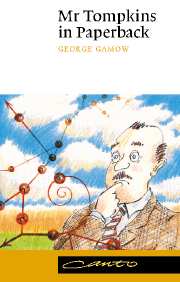Book contents
- Frontmatter
- FOREWORD
- PREFACE
- Contents
- Acknowledgements
- INTRODUCTION
- 1 City Speed Limit
- 2 The Professor's Lecture on Relativity which caused Mr Tompkins's dream
- 3 Mr Tompkins takes a holiday
- 4 The Professor's Lecture on Curved Space, Gravity and the universe
- 5 The Pulsating Universe
- 6 Cosmic Opera
- 7 Quantum Billiards
- 8 Quantum Jungles
- 9 Maxwell's Demon
- 10 The Gay Tribe of Electrons
- 10½ A Part of the Previous Lecture which Mr Tompkins slept through
- 12 Inside the Nucleus
- 13 The Woodcarver
- 14 Holes in Nothing
- 15 Mr Tompkins Tastes a Japanese Meal
15 - Mr Tompkins Tastes a Japanese Meal
Published online by Cambridge University Press: 05 June 2013
- Frontmatter
- FOREWORD
- PREFACE
- Contents
- Acknowledgements
- INTRODUCTION
- 1 City Speed Limit
- 2 The Professor's Lecture on Relativity which caused Mr Tompkins's dream
- 3 Mr Tompkins takes a holiday
- 4 The Professor's Lecture on Curved Space, Gravity and the universe
- 5 The Pulsating Universe
- 6 Cosmic Opera
- 7 Quantum Billiards
- 8 Quantum Jungles
- 9 Maxwell's Demon
- 10 The Gay Tribe of Electrons
- 10½ A Part of the Previous Lecture which Mr Tompkins slept through
- 12 Inside the Nucleus
- 13 The Woodcarver
- 14 Holes in Nothing
- 15 Mr Tompkins Tastes a Japanese Meal
Summary
One weekend Maud went away to visit her aunt in Yorkshire, and Mr Tompkins invited the professor to have dinner with him in a famous sukiyaki restaurant. Sitting on the soft cushions at a low table, they were enjoying all the delicacies of the Japanese kitchen and sipping sake from little cups.
‘Tell me,’ said Mr Tompkins. ‘The other day I heard Dr Tallerkin saying in his lecture that the protons and the neutrons in a nucleus were held together by some kinds of nuclear forces. Are those the same forces which hold electrons in an atom?’
‘Oh, no!’ answered the professor. ‘Nuclear forces are something quite different. Atomic electrons are attracted to the nucleus by ordinary electrostatic forces first studied in detail by a French physicist, CHARLES AUGUSTIN DE COULOMB, toward the end of the eighteenth century. They are comparatively weak and decrease in inverse proportion to the square of the distance from the centre. Nuclear forces are quite different. When a proton and a neutron come close to each other but not yet in direct contact, there are practically no forces between them. But as soon as they come into contact, there appears an extremely strong force which holds them together. It is like two pieces of adhesive tape which do not attract each other at even a small distance but stick together like brothers as soon as they come in touch with each other. Physicists call these forces ‘strong interaction’.
- Type
- Chapter
- Information
- Mr Tompkins in Paperback , pp. 177 - 186Publisher: Cambridge University PressPrint publication year: 1993



